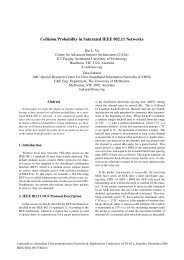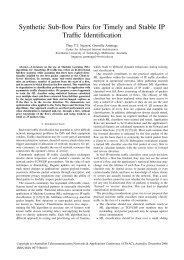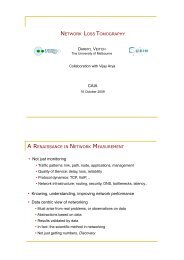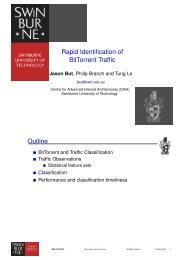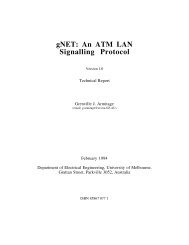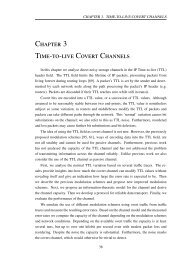Mitigating Sampling Error when Measuring Internet Client IPv6 ...
Mitigating Sampling Error when Measuring Internet Client IPv6 ...
Mitigating Sampling Error when Measuring Internet Client IPv6 ...
You also want an ePaper? Increase the reach of your titles
YUMPU automatically turns print PDFs into web optimized ePapers that Google loves.
DNSv6−capable connections [%]<br />
60<br />
50<br />
40<br />
30<br />
20<br />
10<br />
0<br />
●<br />
16May<br />
2011<br />
Percentage of all DNSv6 capable<br />
● Weekdays<br />
Weekend<br />
25Jun<br />
2011<br />
● ●<br />
04Aug<br />
2011<br />
13Sep<br />
2011<br />
●<br />
Date<br />
23Oct<br />
2011<br />
●<br />
02Dec<br />
2011<br />
11Jan<br />
2012<br />
●<br />
20Feb<br />
2012<br />
Figure 8: Percentage of all connections with <strong>IPv6</strong>-capable resolving<br />
DNS server<br />
country <strong>IPv6</strong> capabilities, dual stack failures and happy eyeballs<br />
usage.<br />
5.1 Overall <strong>IPv6</strong> capabilities<br />
First we analyse the proportions of the connections where the<br />
client’s resolving DNS server was <strong>IPv6</strong>-capable (DNSv6-capable),<br />
the client was <strong>IPv6</strong>-capable (<strong>IPv6</strong>-capable), the client preferred<br />
<strong>IPv6</strong> over IPv4 in dual-stack (<strong>IPv6</strong>-preferred), or could be forced to<br />
use <strong>IPv6</strong> with a literal URL (<strong>IPv6</strong>-forced). We plot the proportions<br />
for weekdays/workdays (WD) and weekends (WE).<br />
Figure 8 shows the percentage of DNSv6-capable connections.<br />
The graph shows a clear uptrend from 40% to nearly 60% during<br />
our measurement period, meaning the percentage of connections<br />
from clients with resolving dual-stack DNS servers has increased.<br />
A slightly smaller weekend percentage suggests that fewer home<br />
user connections are DNSv6-capable.<br />
Figure 9 shows the percentages of <strong>IPv6</strong>-capable, <strong>IPv6</strong>-preferred,<br />
and <strong>IPv6</strong>-forced. The percentage of <strong>IPv6</strong>-capable decreased<br />
slightly from 6–7% around World <strong>IPv6</strong> day 2011 (Wednesday<br />
8th of June), during which major <strong>Internet</strong> network and service<br />
providers enabled <strong>IPv6</strong> as a test, to 6% with not much difference between<br />
weekdays and weekends. The percentage of <strong>IPv6</strong>-preferred<br />
connections decreased from its peak of 2.5% around <strong>IPv6</strong> day to<br />
1–2% in July 2011 and has remained relatively constant since then.<br />
The percentage of <strong>IPv6</strong>-preferred is higher during weekdays suggesting<br />
that home users were less likely to prefer <strong>IPv6</strong> (probably<br />
because they were less likely to use native <strong>IPv6</strong>).<br />
The percentage of <strong>IPv6</strong>-forced is basically the percentage of<br />
<strong>IPv6</strong>-capable plus 15–20% of connections originating from Windows<br />
Vista and Windows 7 hosts that support <strong>IPv6</strong> via Teredo, but<br />
by default do not query for DNS AAAA records (see Section 2.1).<br />
The percentage of Teredo is almost 5% higher on weekends suggesting<br />
that Teredo is more likely used by home users. We think<br />
this is because Teredo is less likely to work in company networks<br />
due to being disabled or filtered by firewalls.<br />
Only 6% of connections were from <strong>IPv6</strong>-capable clients, but for<br />
11–12% of connections we observed DNS AAAA requests. We<br />
think the difference is mainly due to hosts that request AAAA<br />
records even if they have no <strong>IPv6</strong> interfaces. For example, some<br />
older Firefox browsers cause this and it is a common default on<br />
Linux [30]. However, <strong>IPv6</strong> failures may also contribute to the difference.<br />
A detailed analysis is future work.<br />
Figure 10 shows a breakdown of the <strong>IPv6</strong>-capable connections<br />
into those using “native” <strong>IPv6</strong> (including point-to-point tunnels and<br />
<strong>IPv6</strong> forced, capable, preferred<br />
connections [%]<br />
35<br />
30<br />
25<br />
20<br />
15<br />
10<br />
Percentage of all <strong>IPv6</strong> forced, capable, preferred<br />
5<br />
0<br />
●<br />
16May<br />
2011<br />
● Forced WD<br />
Forced WE<br />
●<br />
25Jun<br />
2011<br />
04Aug<br />
2011<br />
●<br />
Capable WD<br />
Capable WE<br />
13Sep<br />
2011<br />
Date<br />
23Oct<br />
2011<br />
Preferred WD<br />
Preferred WE<br />
● ● ●<br />
02Dec<br />
2011<br />
11Jan<br />
2012<br />
20Feb<br />
2012<br />
Figure 9: Percentage of all connections from hosts that were<br />
<strong>IPv6</strong>-capable, preferred <strong>IPv6</strong> in dual-stack, or could be forced<br />
to use <strong>IPv6</strong> with a literal URL<br />
Percentage of all that are <strong>IPv6</strong> unicast, 6to4, Teredo capable<br />
Native, 6to4, Teredo connections [%]<br />
7<br />
6<br />
5<br />
4<br />
3<br />
2<br />
1<br />
0<br />
●<br />
16May<br />
2011<br />
● Native WD<br />
Native WE<br />
25Jun<br />
2011<br />
04Aug<br />
2011<br />
6to4 WD<br />
6to4 WE<br />
● ● ●<br />
13Sep<br />
2011<br />
Date<br />
23Oct<br />
2011<br />
Teredo WD<br />
Teredo WE<br />
●<br />
02Dec<br />
2011<br />
11Jan<br />
2012<br />
●<br />
20Feb<br />
2012<br />
Figure 10: Percentage of all connections from <strong>IPv6</strong>-capable<br />
hosts by <strong>IPv6</strong> type (native, 6to4, Teredo)<br />
6rd [31]), 6to4, or Teredo based on the <strong>IPv6</strong> address prefixes. 4 Over<br />
70% of the connections from <strong>IPv6</strong>-capable hosts used 6to4 tunnelling<br />
(4–5% of all connections), 20–30% of <strong>IPv6</strong>-capable connections<br />
came from hosts with native addresses (1–2% of all connections),<br />
and only 2–3% of <strong>IPv6</strong>-capable connections used Teredo<br />
– manually fully-enabled Windows Teredo or Teredo on other OS<br />
(0.1–0.2% of all connections).<br />
Native <strong>IPv6</strong> peaked in the week of <strong>IPv6</strong>-day, then decreased<br />
slightly and has remained relatively steady since (with a possibly<br />
very small uptrend). The percentage of 6to4 has decreased slightly<br />
over time. On weekends there are significantly fewer connections<br />
from hosts using native <strong>IPv6</strong>, but more connections from hosts using<br />
6to4. During the week this reverses. This suggests a higher<br />
native <strong>IPv6</strong> usage at work places.<br />
Figure 11 shows that 90–100% of connections from hosts with<br />
native <strong>IPv6</strong> prefer <strong>IPv6</strong> in dual-stack. However, the percentage<br />
has decreased over time. We suspect this happened because of an<br />
increased use of happy eyeballs, which fails over very quickly from<br />
<strong>IPv6</strong> to IPv4 (see Section 5.6). Only 0.5–1% of <strong>IPv6</strong>-capable 6to4<br />
connections preferred <strong>IPv6</strong> in dual-stack, and well under 0.1% of<br />
Teredo connections preferred <strong>IPv6</strong> in dual-stack (Teredo omitted in<br />
Figure 11).<br />
4 The 6to4 protocol uses the prefix 2002::/16 and the Teredo protocol<br />
uses the prefix 2001:0::/32 [1, 2]. We ignore older <strong>IPv6</strong>-over-<br />
IPv4 tunnelling technologies since they are not common [5, 13].



